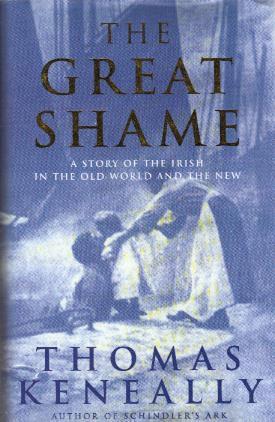
1998

|
The Great Shame 1998 |
Dustjacket synopsis:
"In the nineteenth century, the Irish population halved. The Great Shame, a
remarkable work of non-fiction based on a quest not unlike Thomas Keneally's previous quest
for Oskar Schindler, traces the three causes of this depletion: the famine; the emmigrations;
and the transportations to Australia. Based on unique research among little-used sources,
this masterly book covers eighty years of Irish history, told through the intimate lens of
political prisoners - some of them ancestors of the Keneally family - who served time as
convicts in Australia.
"Beginning with Hugh Larkin, a twenty-four-year-old 'Ribbonman' transported for life in 1833, The Great Shame tells of the Ireland these prisoners came from and the Australia they encountered. It brings us close to Irish women such as Esther, wife of Larkin, and to the future Lady Wilde, mother of Oscar, friend and collaborator of notable Irish prisoners. But we also encounter the 'Female Factory' and the Irish convict women who married humble protest criminals, and we learn of the often desperate survival methods of 'transportation-widowed' women left in Ireland.
"Throughout the nineteenth century, Australian and American organisations participated in the extraordinary escapes or attempted escapes from Australia of some of the world-famous Irish politicals. Amongst these was William Smith O'Brien, nobleman, leader of an uprising at the height of the Irish Famine, who became, from solitary confinement in Van Diemen's Land, the Nelson Mandela of his age. Thomas Francis Meagher's spectacular escape led to a glittering American career as orator, Union general, and tragic Governor of Montana. John Mitchel, Meagher's friend in Van Diemen's exile, became a Confederate newspaperman, gave two of his sons to the Confederate cause, was imprisoned with Jefferson Davis, but emerged to reinfiltrate Ireland and become Member for Tipperary.
"Through many such lives, famous and obscure, we see not only the daily experience of famine sufferers and Irish activists, but also the astonishing history of the Irish diaspora: to the St Lawrence, to New York, to the high plains of Montana and the bush towns of New South Wales. All of them are vividly present in this epic tale of Australian imprisonment, Irish disaster and new world redemption."
First Paragraph (from the Preface):
After Stephen Spielberg's film Schindler's List revived interest in the story that I had told in my novel Schindler's Ark, I was frequently, to my embarrassment, thanked for having documented on a human scale, through jaunty, disreputable Oskar Schindler, the Jewish catastrophe of the Second World War. I stumbled on the story, written it with passion because it was a great tale, and now with a delighted and slightly guilty bemusement found that people, particularly the Jewish community throughout the world, were talking to me as if I had done something larger - had to an extent validated the past for those who had lived through it, and had restored their history to their children.
What of my own past? I was born in Australia, and I knew that my name and ancestors were Irish. I knew vaguely that I had some forebears who were convicts, one of them a John Kenealy who served time in Western Australia as a political prisoner. I discovered too that I had married the great-granddaughter of what one historian calls 'a protest criminal', a so-called Ribbonman - sent from Ireland to Australia for life in the decade before the Irish Famine, which began in 1845. This, if it is a boast, is not such an uncommon one in Australia, even if earlier generations of Australians would have suppressed what they then perceived as genealogical stains. I knew that, throughout the nineteenth century, until the last shipload of Fenian prisoners arrived in Western Australia in 1968, and until the last political prisoner had died in exile well into the twentieth century, Australia was the potential punishment that hung over all protest, political activism and revolt in the British Empire - over the Chartists of Britain, the French habitants of Lower Canada and the republicans of Upper Canada, but in particular over gestures of protest and rebellion in Ireland.
I wanted to try to tell the tale of the Irish in the new world and the old through the experiences of those transported to Australia for gestures of social and political dissent. The suppression of dissent in Ireland of course marked both Ireland itself, the point of departure, and Australia, the shore of exile. But Australia's place as a zone of sub-Antarctic political punishment would also influence the intense and fatally riven Irish politics of emigrant societies in the United States, Britain and Canada, and I wanted to try to tell some of that tale as well.
From the Random House hardback edition, 1998.
Notes:
Tom Keneally's publisher, Random House Australia
conducted an interview
with Keneally after the publication of The Great Shame.
On the publication of The Great Shame a number of articles were published in the Australian press about Tom Keneally and this new book. Murray Waldren wrote a long, informative piece in The Weekend Australian titled The Great Obsession.
This page and its contents are copyright © 1998-2004 by Perry Middlemiss, Melbourne, Victoria, Australia.
Last modified: March 28, 2004.